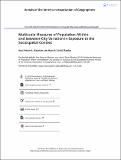Files in this item
Multiscale measures of population : within- and between-city variation in exposure to the sociospatial context
Item metadata
| dc.contributor.author | Petrović, Ana | |
| dc.contributor.author | van Ham, Maarten | |
| dc.contributor.author | Manley, David | |
| dc.date.accessioned | 2018-02-06T10:30:05Z | |
| dc.date.available | 2018-02-06T10:30:05Z | |
| dc.date.issued | 2018-01-29 | |
| dc.identifier | 251476905 | |
| dc.identifier | abe286d1-8917-4ad9-aeb5-148be5c84889 | |
| dc.identifier | 85041233130 | |
| dc.identifier | 000434437400010 | |
| dc.identifier.citation | Petrović , A , van Ham , M & Manley , D 2018 , ' Multiscale measures of population : within- and between-city variation in exposure to the sociospatial context ' , Annals of the American Association of Geographers , vol. 108 , no. 4 , pp. 1057-1074 . https://doi.org/10.1080/24694452.2017.1411245 | en |
| dc.identifier.issn | 2469-4452 | |
| dc.identifier.other | ORCID: /0000-0002-2106-0702/work/64697521 | |
| dc.identifier.uri | https://hdl.handle.net/10023/12674 | |
| dc.description.abstract | Appreciating spatial scale is crucial for our understanding of the socio-spatial context. Multi-scale measures of population have been developed in the segregation and neighbourhood effects literatures, which have acknowledged the role of a variety of spatial contexts for individual outcomes and inter-group contacts. Although existing studies dealing with socio-spatial inequalities increasingly explore the effects of spatial scale, there has been little systematic evidence on how exposure to socio-spatial contexts changes across urban space, both within and between cities. This paper presents a multi-scale approach to measuring potential exposure to others. Using individual level register data for the full population of the Netherlands, and an exceptionally detailed multi-scalar framework of bespoke neighbourhoods at 101 spatial scales, we measured the share of non-Western ethnic minorities for three Dutch cities with different urban forms. We created individual and cumulative distance profiles of ethnic exposure, mapped ethnic exposure surfaces, and applied entropy as a measure of scalar variation to compare potential exposure to others in different locations both within and between cities. The multi-scale approach can be implemented for examining a variety of social processes, notably segregation and neighbourhood effects. | |
| dc.format.extent | 18 | |
| dc.format.extent | 1401877 | |
| dc.language.iso | eng | |
| dc.relation.ispartof | Annals of the American Association of Geographers | en |
| dc.subject | Distance profile | en |
| dc.subject | Entropy | en |
| dc.subject | Ethnic exposure | en |
| dc.subject | Spatial scale | en |
| dc.subject | Urban form | en |
| dc.subject | G Geography (General) | en |
| dc.subject | H Social Sciences (General) | en |
| dc.subject | 3rd-NDAS | en |
| dc.subject | BDC | en |
| dc.subject | R2C | en |
| dc.subject.lcc | G1 | en |
| dc.subject.lcc | H1 | en |
| dc.title | Multiscale measures of population : within- and between-city variation in exposure to the sociospatial context | en |
| dc.type | Journal article | en |
| dc.contributor.institution | University of St Andrews. School of Geography & Sustainable Development | en |
| dc.identifier.doi | 10.1080/24694452.2017.1411245 | |
| dc.description.status | Peer reviewed | en |
This item appears in the following Collection(s)
Items in the St Andrews Research Repository are protected by copyright, with all rights reserved, unless otherwise indicated.

